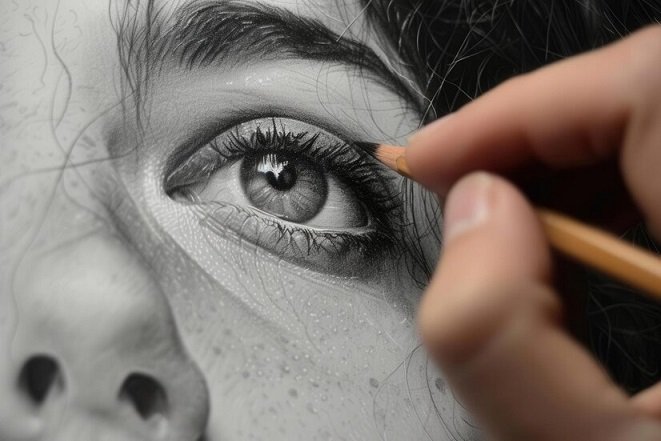
Anime Eyes Drawing
Drawing anime eyes is one of the most crucial skills for any aspiring artist. The eyes are often referred to as the windows to the soul, and in anime, they convey a myriad of emotions and personality traits. In this guide, we will delve deeply into the intricate process of drawing anime eyes, ensuring you gain a thorough understanding of the techniques required to create captivating and expressive eyes.
Understanding the Basics of Anime Eyes
Anime eyes vary significantly in style, size, and complexity, depending on the artist’s preference and the character’s personality. However, there are some fundamental elements common to most anime eyes that you must grasp before moving on to more advanced techniques.
Proportions and Placement
To begin with, the proportions of anime eyes are essential. Typically, anime eyes are much larger compared to realistic human eyes, occupying a substantial portion of the face. This exaggerated size helps convey emotions more vividly. When placing the eyes on the face, ensure they are level with each other and symmetrically aligned. The distance between the eyes is usually about the width of one eye.
Basic Shapes and Forms
Anime eyes often start as simple geometric shapes. For example, many artists use an oval or almond shape as the base. The shape can vary—rounder eyes for younger or more innocent characters, and more angular shapes for older or more intense characters. Understanding the basic shapes will help you maintain consistency and develop your unique style.
Sketching the Outline
Begin by lightly sketching the outline of the eyes. Use a pencil for this stage, as you’ll need to refine and adjust your lines. Start with the upper eyelid, which often has a thicker line to emphasize the eye’s shape. Next, sketch the lower eyelid, which is typically thinner and lighter.
Adding Detail to Anime Eyes
Once the basic outline is in place, it’s time to add details that bring the eyes to life.
Iris and Pupil
The iris is one of the most critical parts of the eye, contributing to its depth and realism. Draw a large circle within the eye shape for the iris. The size of the iris can vary, but it should generally be large enough to cover a significant portion of the eye. Within the iris, draw the pupil as a smaller circle. The pupil can be perfectly round or slightly elongated, depending on the character’s design.
Reflections and Highlights
Adding reflections and highlights is essential for making anime eyes appear vibrant and lively. Typically, highlights are added in the form of small circles or ovals, positioned on the upper part of the iris. You can add multiple highlights to create a sparkling effect. Ensure these highlights are consistent in both eyes to maintain symmetry.
Eyelashes
Eyelashes play a crucial role in defining the eye’s shape and adding to its expressiveness. For female characters, eyelashes are often more pronounced, with several long, curved lines extending from the upper eyelid. Male characters usually have shorter, subtler eyelashes. Be mindful of the direction and curvature of each lash to maintain a natural appearance.
Shading and Coloring Anime Eyes
Shading and coloring are vital for adding depth and dimension to anime eyes.
Basic Shading Techniques
Start by identifying the light source in your drawing. This will determine where the shadows and highlights should be. Use a soft pencil or blending tool to shade the areas of the iris that are further from the light source, creating a gradient effect. The pupil should be the darkest part of the eye, with the iris gradually lightening towards the highlights.
Advanced Shading
For more advanced shading, consider adding multiple layers of shadows and gradients. This technique involves building up the darkness in several stages, creating a more realistic and three-dimensional look. Pay special attention to the edges of the iris and the areas around the highlights, as these can significantly enhance the eye’s depth.
Coloring Techniques
When coloring anime eyes, choose colors that complement the character’s overall design. Use a base color for the iris, then add darker shades around the edges and lighter tones near the highlights. Digital artists can use blending tools and layers to achieve smooth transitions between colors. Traditional artists can use colored pencils or markers, blending them carefully to avoid harsh lines.
Expressing Emotions Through Anime Eyes
Anime eyes are a powerful tool for conveying emotions. By adjusting various elements, you can depict a wide range of feelings.
Happiness and Joy
To express happiness, draw the eyes with an upward curve on the upper eyelid, and add large highlights to create a sparkling effect. The eyes may appear more open and rounded, with raised eyebrows to enhance the expression.
Sadness and Tears
For sadness, draw the eyes with a downward curve on the upper eyelid and smaller, less prominent highlights. Adding tears can amplify the emotion. Draw the tears as small, round drops or streams running down the face.
Anger and Intensity
Angry eyes typically have a more angular shape, with a sharp downward curve on the upper eyelid and smaller, intense highlights. The eyebrows should be drawn closer together and angled downwards to convey frustration or anger.
Surprise and Shock
To depict surprise, draw the eyes wide open, with large, round irises and prominent highlights. The eyebrows should be raised high on the forehead, and the pupils can be smaller to emphasize the shock.
Practicing and Refining Your Skills
Mastering the art of drawing anime eyes requires practice and patience. Here are some tips to help you improve:
Study Reference Materials
Look at a variety of anime styles and artists to understand different approaches to drawing eyes. Analyze how professional artists use shapes, highlights, and shadows to create expressive eyes.
Practice Consistently
Dedicate time each day to practice drawing eyes. Start with simple shapes and gradually add more details as you become more comfortable. Experiment with different emotions and styles to broaden your skills.
Seek Feedback
Share your work with others and seek constructive feedback. Join online communities or art classes where you can receive guidance and tips from more experienced artists.
Experiment with Techniques
Don’t be afraid to try new techniques and tools. Whether you’re using traditional pencils, markers, or digital software, experimenting with different mediums can help you discover new methods and improve your art.
Conclusion
Drawing anime eyes is an art form that requires a keen understanding of proportions, shapes, and details. By mastering the basics and continually refining your techniques, you can create eyes that are not only beautiful but also deeply expressive. Remember, practice is key to improvement, so keep experimenting and seeking inspiration from various sources. Happy drawing!





